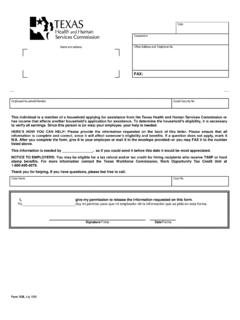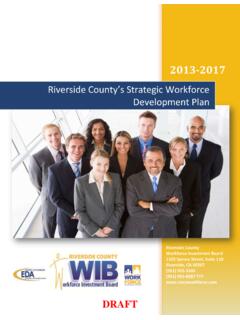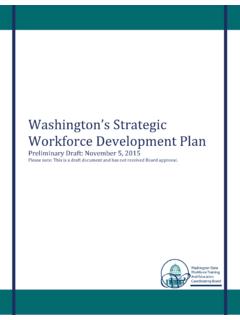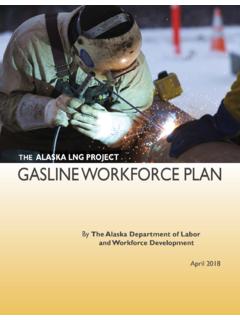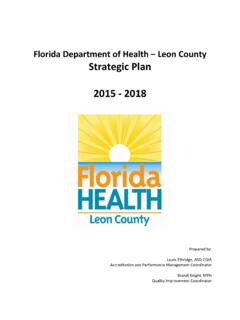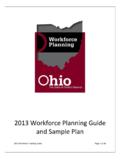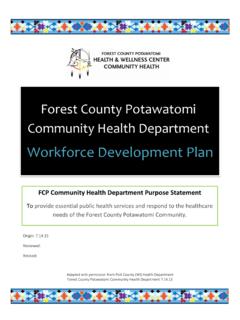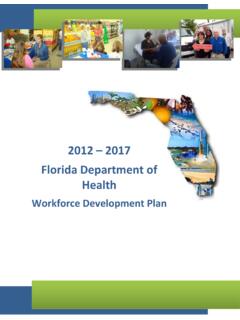Transcription of Golden Crescent Workforce Development Board Strategic …
1 Golden Crescent Workforce Development Board Strategic and operational plan 2017 2020 AN EQUAL OPPORTUNITY EMPLOYER / PROGRAM Auxiliary aids and services are available upon request to individuals with disabilities Relay Texas: 1-800-735-2989 (TTY); 1-800-735-2988 (Voice); 1-800-622-4954 (Espa ol) 1 Table of Contents Part A: Strategic Elements Boards Vision 1. A description of the Board s Strategic vision to support regional economic growth and economic self-sufficiency. a. goals for preparing an educated and skilled Workforce , including youth and individuals with barriers to employment; and b. goals relating to the performance accountability measures based on performance indicators described in WIOA 116(b)(2)(A). 2. A description of the Board s strategy to work with the entities carrying out the core programs and with the required partners to align resources available to the local area, to achieve the vision and goals.
2 Economic and Workforce Analysis 1. A regional analysis of the following: a. The economic conditions, including existing and emerging in-demand industry sectors and occupations, as well as targeted occupations b. The employment needs of employers in existing and emerging in-demand industry sectors and occupations 2. A list of the in-demand industry sectors and occupations. 3. A list of the target industry sectors and occupations. 4. An analysis of the knowledge and skills needed to meet the employment needs of the employers in the region, including employment needs in in-demand sectors and occupations. 5. An analysis of the regional Workforce , including current labor force employment and unemployment data, information on labor market trends, and educational and skill levels of the Workforce , including individuals with barriers to employment.
3 6. An analysis of Workforce Development activities in the Golden Crescent , including education and training. This analysis includes the strengths and weaknesses of Workforce Development activities and an evaluation of the effectiveness of programs and services. It evaluates the Board s capacity to provide Workforce Development activities to address the identified education and skills needs of the Workforce . The analysis also includes serving individuals with barriers to employment and the employment needs of business and industry. 2 Part B: operational Elements The operational Elements of the plan are as follows: 1. A description of the Workforce Development system in the local area that identifies: a. the programs that are included in the system; and b. how the Board will support the strategy identified in the State plan and work with the entities carrying out core programs and other Workforce Development programs, including programs of study authorized under the Carl D.
4 Perkins Career and Technical Education Act of 2006, that support the strategy identified in the State plan under WIOA 102(b)(1)E). 2. A description of how the Board will work with entities carrying out core programs to: a. expand access to employment, training, education, and supportive services for eligible individuals, particularly eligible individuals with barriers to employment; b. facilitate the Development of career pathways and coenrollment, as appropriate, in core programs; and c. improve access to activities leading to a recognized postsecondary credential (including a credential that is an industry-recognized certificate or certification, portable, and stackable). 3. A description of the strategies for coordinating programs and services for target populations.
5 4. A description of the strategies and services that will be used in our area: a. To facilitate engagement of employers in the Workforce Development programs, including small employers and employers in in-demand industry sectors and occupations b. To support a local Workforce Development system that meets the needs of businesses in the local area c. To better coordinate Workforce Development programs and economic Development d. To strengthen linkages between the one-stop delivery system and unemployment insurance programs Note: This includes the implementation of initiatives such as incumbent worker training programs, on-the-job training programs, customized training programs, industry and sector strategies, career pathways initiatives, use of effective business intermediaries, and other business services and strategies designed to meet the needs of regional employers.
6 These initiatives must support the strategy described above. 5. An explanation of how the Board will coordinate local Workforce investment activities with regional economic Development activities that are carried out in the local area and how the Board will promote entrepreneurial-skills training and microenterprise services. 3 6. A description of the one-stop delivery system in the local area, including explanations of the following: a. How the Board will ensure the continuous improvement of eligible providers and how providers will meet the employment needs of local employers, workers, and job seekers; b. How the Board will facilitate access to services provided through the one-stop delivery system, including to remote areas, through the use of technology and other means; c.
7 How entities within the one-stop delivery system, including the one-stop operators and the one-stop partners, will comply with WIOA 188, if applicable, and with applicable provisions of the Americans with Disabilities Act of 1990 regarding the physical and programmatic accessibility of facilities, programs and services, technology, and materials for individuals with disabilities, including providing staff training and support for addressing the needs of individuals who have disabilities; and d. The roles and resource contributions of the one-stop partners. 7. A description and assessment of the type and availability of adult and dislocated worker employment and training activities in the local area. 8. A description of how the Board will coordinate Workforce investment activities carried out in the local area with statewide rapid response activities described in WIOA 134(a)(2)(A).
8 9. A description and assessment of the type and availability of Workforce investment activities for youth in the local area, including activities for youth who have disabilities. This description must include an identification of successful models of such activities. 10. A description of how the Board will coordinate relevant secondary- and postsecondary-education programs and activities with education and Workforce investment activities to coordinate strategies, enhance services, and avoid duplication of services. 11. A description of how the Board will provide transportation, including public transportation, and other appropriate support services in the local area in coordination with WIOA Title I Workforce investment activities. 12. A description of plans, assurances, and strategies for maximizing coordination, improving service delivery, and avoiding duplication of Wagner-Peyser Act services and other services provided through the one-stop delivery system.
9 4 13. A description of how the Board will coordinate WIOA Title I Workforce investment activities with Adult Education and Literacy activities under WIOA Title II. This description must include how the Board will carry out the review of local applications submitted under Title II consistent with WIOA 107(d)(11)(A) and (B)(i) and WIOA 232. 14. Provide copies of executed cooperative agreements that explain how all local service providers, including additional providers, will carry out the requirements for integration of and access to the entire set of services available in the local one-stop delivery system. This includes cooperative agreements (as defined in WIOA 107(d)(11)) between the Board or other local entities described in 101(a)(11)(B) of the Rehabilitation Act of 1973 (29 721(a)(11)(B)) and the local office of a designated state agency or designated state unit that administers programs that are carried out under Title I of the Rehabilitation Act (29 720 et seq.)
10 (other than 112 or part C of that title (29 732, 741) and are subject to 121(f)) in accordance with 101(a)(11) of the Rehabilitation Act (29 721(a)(11)) with respect to efforts that will enhance the provision of services to individuals who have disabilities and to other individuals, such as cross training of staff, technical assistance, use and sharing of information, cooperative efforts with employers, and other efforts. 15. An identification of the entity responsible for the disbursal of grant funds described in WIOA 107(d)(12)(B)(i)(III), as determined by the chief elected officials or the governor under WIOA 107(d)(12)(B)(i). 16. A description of the competitive process that will be used to award the sub-grants and contracts for WIOA Title I activities.
